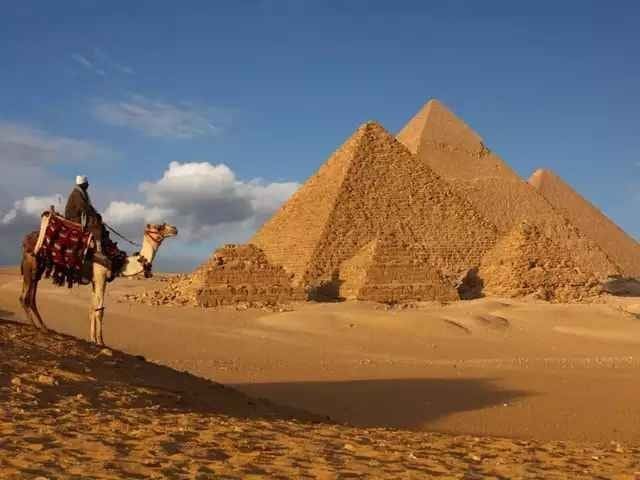The construction of the Great Pyramid of Giza stands as one of the most perplexing and awe-inspiring achievements in the history of human civilization. Situated on the Giza Plateau, just outside Cairo, Egypt, this architectural marvel has fascinated archaeologists, historians, and curious minds for centuries. In this article, we delve deep into the enigma that shrouds the construction of the Great Pyramid and explore the various theories that attempt to unravel its secrets.
The Great Pyramid: An Unparalleled Feat
The Basics
The Great Pyramid, also known as the Pyramid of Khufu or the Pyramid of Cheops, is the largest and oldest of the three pyramids on the Giza Plateau. It was constructed during the Fourth Dynasty of the Old Kingdom of Egypt, around 2580-2560 BC. This colossal structure initially stood at an impressive 146.6 meters (481 feet), making it the tallest man-made structure on Earth for over 3,800 years.
Unparalleled Precision
One of the most astounding aspects of the Great Pyramid’s construction is its precision. The massive limestone and granite blocks used in its construction were quarried, transported, and assembled with remarkable accuracy. The average block used in the construction weighed approximately 2.5 tons, and some of the granite blocks weighed an astonishing 80 tons. The alignment and orientation of the pyramid are also incredibly precise, with only a fraction of a degree of error.
Also check: The Surprising Benefits of Healing Crystals
Theories Surrounding Construction
Traditional Egyptian Labor
One of the most widely accepted theories is that the construction of the Great Pyramid was accomplished by a massive workforce of skilled laborers. These workers, often believed to be conscripted peasants, are thought to have used simple tools like copper chisels and wooden sleds to transport and position the massive stones. However, this theory raises questions about the logistics of managing such a vast labor force and providing them with sustenance.
The Ramp Theory
Another prominent theory suggests the use of a massive, spiraling ramp to transport the stone blocks to higher levels of the pyramid as it was built. While this theory seems plausible, it prompts questions about the logistics of constructing such a ramp and how it could have been built without leaving substantial archaeological evidence.
Advanced Ancient Technology
Some theorists propose that the construction of the Great Pyramid involved advanced technologies or techniques that have been lost to history. Ideas range from anti-gravity devices to sound or vibration-based methods for moving and lifting the stones. While these ideas capture the imagination, they lack concrete evidence to support their claims.
Also check: The Kraken – An In-Depth Exploration of Myth, Literature and Symbolism
Unanswered Questions
Precision and Alignment
The remarkable precision and alignment of the Great Pyramid continue to baffle researchers. How were the builders able to achieve such accuracy with the tools and technology available at the time?
Labor Force
The sheer number of laborers required for the construction is a point of contention. Estimates range from tens of thousands to hundreds of thousands. How were these workers housed, fed, and managed?
Purpose and Symbolism
While the Great Pyramid is often associated with pharaohs’ tombs, its true purpose remains a mystery. Was it solely a tomb, or did it serve other functions or hold deeper symbolic meanings?
Unraveling the Mystery
Alien Theories
Among the more unconventional theories about the construction of the Great Pyramid are the ideas that it might have had extraterrestrial involvement. Some proponents argue that the precision and alignment of the pyramid could only be achieved with advanced technology beyond the capabilities of ancient Egyptians. While this theory is captivating, it lacks solid evidence and is often considered speculative.
Mathematical Significance
The Great Pyramid is filled with mathematical and geometric wonders. Its dimensions are believed to hold profound numerical significance. For instance, the pyramid’s height is thought to be directly related to the mathematical constant pi, and its base supposedly reflects the Earth’s northern hemisphere. These mathematical connections continue to baffle experts and raise questions about the pyramid’s true purpose.
Cultural Legacy
Beyond its architectural brilliance, the Great Pyramid of Giza holds immense cultural and historical significance. It is often seen as a symbol of Egypt’s ancient civilization and its connection to the pharaohs. The pyramid is an integral part of Egypt’s cultural heritage and attracts millions of tourists each year, providing a vital source of income for the country.
Ongoing Research
In recent years, technological advancements have allowed researchers to explore the Great Pyramid’s secrets more comprehensively. Non-invasive techniques such as ground-penetrating radar and 3D scanning have revealed hidden chambers and structures within the pyramid. These discoveries have ignited new debates and theories about its purpose and construction.
The Importance of Preservation
Preserving the Great Pyramid and the surrounding archaeological sites is of paramount importance. As a UNESCO World Heritage Site, it is crucial to ensure that the monument remains intact for future generations to study and admire. Efforts are ongoing to protect the pyramid from the effects of time, pollution, and the wear and tear of tourism.
The Geological Connection
One intriguing theory that has gained traction in recent years involves the geological origin of the pyramid’s stones. Some researchers have proposed that the builders may have taken advantage of natural limestone outcrops in the Giza Plateau. By selecting stones that were already present in the vicinity, they could have reduced the need for long-distance transportation. This theory would explain the precision of the pyramid’s alignment with the cardinal points, as well as the abundance of local limestone.
Water-Based Construction
Another innovative theory posits that water played a vital role in the construction process. It suggests that a series of canals and pools could have been strategically placed around the pyramid to facilitate the movement of massive stone blocks. By using the principles of buoyancy and water displacement, workers could have floated the heavy stones into position with greater ease. This hypothesis raises questions about the existence of an ancient canal system and the organization required to manage it.
Mathematical Marvels
The Great Pyramid’s mathematical intricacies continue to astound researchers. Its dimensions, angles, and proportions are believed to encode a wealth of mathematical information, including the Golden Ratio, Pi, and the Earth’s dimensions. Some theorists argue that these mathematical features were intentional, representing a profound knowledge of geometry and astronomy possessed by the pyramid’s builders.
Astronomical Alignments
The alignment of the Great Pyramid with celestial bodies has led to intriguing speculation about its connection to ancient astronomy. Some researchers suggest that the pyramid’s shafts and chambers were designed to align with specific stars or constellations during significant celestial events. This could indicate an astronomical or spiritual purpose for the pyramid beyond mere burial.
Sustainable Building Practices
The construction of the Great Pyramid was undoubtedly a massive undertaking, but some experts propose that it may have been more sustainable than previously thought. By utilizing renewable materials like wood and papyrus for scaffolding and employing a well-organized labor force, the ancient Egyptians could have minimized the environmental impact of this colossal project.
Modern-Day Exploration
As technology continues to advance, modern researchers are gaining new insights into the Great Pyramid’s structure. Non-invasive techniques, such as LiDAR scanning and thermal imaging, are revealing hidden chambers and passageways, fueling further intrigue and exploration.
Final Thoughts
The Great Pyramid of Giza continues to stand as an enduring enigma, challenging our understanding of ancient engineering, mathematics, and culture. While theories about its construction abound, the truth remains elusive. It serves as a testament to the incredible capabilities of ancient civilizations and their ability to create enduring marvels that continue to inspire and mystify us to this day.
In conclusion, the Great Pyramid of Giza’s secrets remains partially hidden beneath its majestic exterior. As technology advances and research continues, we can only hope that we inch closer to solving the puzzle of how this remarkable structure was built and why. Until then, it will continue to be a symbol of human achievement, a source of wonder, and a beacon of curiosity for generations to come.






Leave a Reply